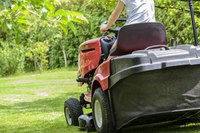Prairie Fare: The great mowing workout — Why I’m ditching the riding mower
(Click an image below to view a high-resolution image that can be downloaded)
I perused the garage looking for my heavy-duty clippers. I wasn’t exactly thrilled with my situation, but I had no one to blame but myself.
I was mowing with a battery-operated push mower, and the area beneath the pine trees needed attention. Unfortunately, I managed to wedge the mower’s shifting mechanism into a mass of low-hanging branches.
It was hot. The grass was thick. The air was humid. And to top it off, the mower battery was dying. So was I.
Meanwhile, my husband was cruising around the backyard on a riding lawn mower. Was this fair?
I have two functioning knees, by the way. He has a bad knee, so he is granted “sitting while mowing” privileges.
After I untangled the mower from the pine tree branches, he zipped around to mow the side front yard on the lawn mower. I was still a bit salty about the situation.
On the positive side, I certainly had achieved my daily physical activity. Unfortunately, I was not wearing a step counter, so I could not flaunt my step count.
After mowing for 90 minutes, I had probably burned 600 calories. He probably burned one-third of those calories.
So there.
I don’t think he cared. He wasn’t red-faced or drenched in sweat. The breeze danced through his hair as he cruised on our nearly 30-year-old turn-on-a-dime riding mower.
He even did “donuts” on the driveway and squealed the lawn mower’s tires.
Yardwork is an excellent workout. It burns a fair number of calories, especially if we do it the hard way. If I used a classic nonmotorized hand mower, I probably would have burned 750 calories, and I probably would have needed paramedics.
Physical activity can reduce our risk for heart disease, some types of cancer and type 2 diabetes. It can also improve our mental health and lessen our chances of depression or dementia.
We have so many tools today to track our activity — apps, smartwatches and even the old-school pedometers that clip onto a waistband.
How many steps should we aim for? For years, 10,000 daily steps of physical activity per day has been the gold standard for fitness. That roughly equals about 5 miles of walking.
If you are very sedentary, you might only gather 2,000 steps per day.
A study published in The Lancet, a medical journal, suggests we may not need quite as many daily steps as once thought.
The researchers analyzed 11 years of published studies, comparing the outcomes of 57 studies with participants 18 years and older. The researchers found the “sweet spot” for improving health outcomes was closer to 7,000 steps per day.
Based on this research, consider counting your steps with some type of device and set goals for increasing your steps. Or, track your minutes of walking or other moderate physical activity such as biking or swimming. The usual goal is 30 minutes of moderate physical activity on most days of the week.
For adults over age 60, the Centers for Disease Control and Prevention reports that 6,000 to 8,000 steps per day is linked to a lower risk of premature death.
I survived my lawn mowing adventure, but now our lawn needs a trim soon. After reviewing all these studies, I will stick with the push mower. It does a nice job and helps me stay healthy.
Next time, though, I’ll start earlier in the day, take water breaks, slather on sunscreen — and yes, I’ll wear a step counter.
Make snacks and beverages count in the summer and all year. When we perspire, we mainly lose water, but we also lose some potassium, sodium, calcium and magnesium. Eating a snack with moisture-rich fruit and dairy can help nourish your body and replenish your electrolytes.
Here’s a nutrient-rich recipe from Iowa State University with a cost of about 32 cents per serving. Whether you're mowing the lawn, walking the dog or dancing in the kitchen, every step counts — literally. A frozen fruit pop never hurts, either.
Berry Banana Popsicles
1 cup strawberries, diced
1 medium banana, diced
2 cups nonfat vanilla yogurt
Rinse strawberries and prepare as directed. Stir all ingredients together in a medium bowl. Place the mixture into popsicle molds or paper cups. Freeze for at least 6 hours. Run the molds under hot water or dip the cups into hot water for easy removal.
Makes eight popsicles. Each has 70 calories, 0 grams (g) fat, 2 g protein, 15 g carbohydrate, 1 g fiber and 30 milligrams sodium.
(Julie Garden-Robinson, Ph.D., R.D., L.R.D., is a North Dakota State University Extension food and nutrition specialist and professor in the Department of Health, Nutrition and Exercise Sciences.)
NDSU Agriculture Communication – July 31, 2025
Source: Julie Garden-Robinson, 701-231-7187, julie.garden-robinson@ndsu.edu
Editor: Dominic Erickson, 701-231-5546, dominic.erickson@ndsu.edu




